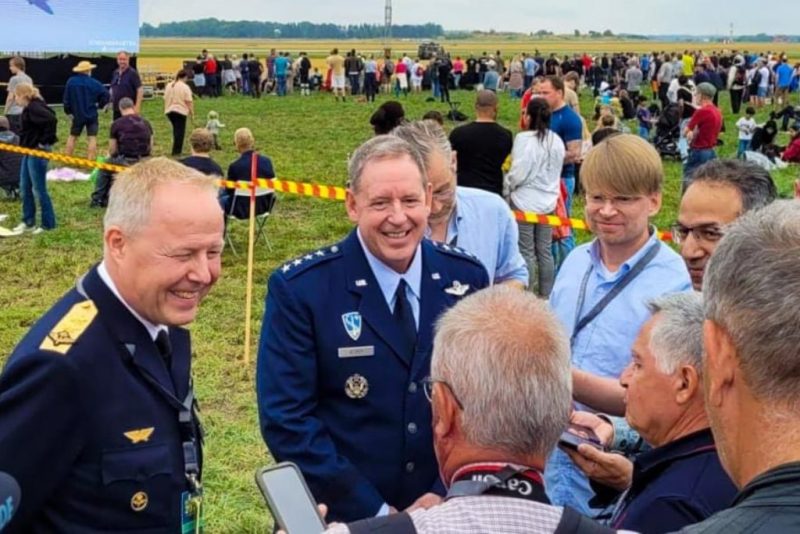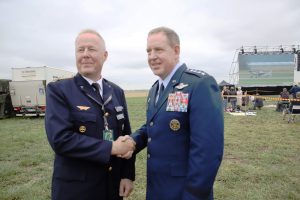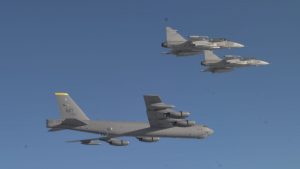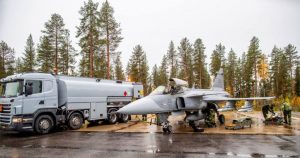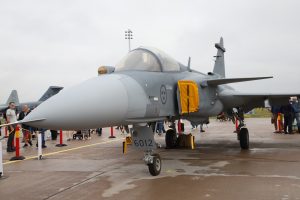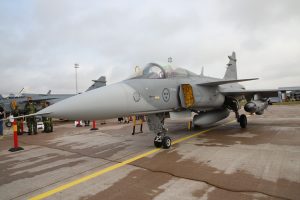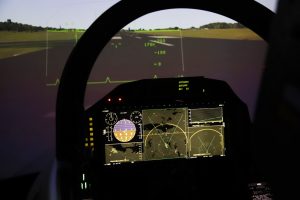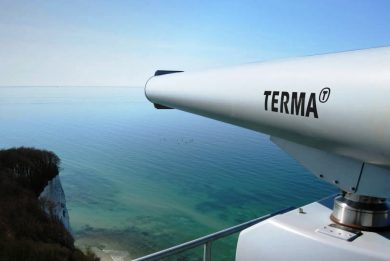“We are not joining NATO, we are becoming NATO,” the commander of the Swedish Air Force says
After a few years of interruption due to the pandemic, on 27 August 2022 the Uppsala Air Base, home of the Uppland Wing of the Swedish Air Force, hosted the Swedish Armed Forces Air Show. The event took place shortly after Stockholm announced the decision to become part of NATO, Sweden signed the Accession Protocols on 5 July, therefore the international participation, mostly from the US Air Force and the German Luftwaffe, was seen under a different light.
After a few years of interruption due to the pandemic, on 27 August 2022 the Uppsala Air Base, home of the Uppland Wing of the Swedish Air Force, hosted the Swedish Armed Forces Air Show. The event took place shortly after Stockholm announced the decision to become part of NATO, Sweden signed the Accession Protocols on 5 July, therefore the international participation, mostly from the US Air Force and the German Luftwaffe, was seen under a different light.
Among the many personalities hosted by the Commander of the Swedish Air Force, Major General Carl-Johan Edström, was USAF General James B. Hecker, who wears two main hats, at NATO level that of Commander Allied Air Command (AAC), which HQ is at Ramstein Air Base, Germany, and at USAF level that of Commander US Air Forces in Europe and US Air Forces Africa (USAFE-AFAFRICA). Gen. Hecker is also the Director of the Joint Air Power Competence Centre based in Kalkar, Germany, which is NATO’s catalyst for the improvement and transformation of Joint Air and Space Power.
Meeting the media, Maj.Gen. Edström underlined Gen. Hecker’s multiple roles highlighting that “He is a key player for Sweden, the Swedish Air Force, and the Nordic air forces when it comes to entering into NATO.” Although not yet part of the Alliance, the Swedish Air Force nonetheless is used to work alongside NATO partners: “The Nordic cooperation began around 20 years ago, we started to do more or less daily training together with Norway, and that prepared us to become a full NATO partner. So in that perspective we are ready, when the time will come,” Maj.Gen. Edström stressed, underlining that the US Air Force Europe has been siding the Swedish Air Force all the way in that period.
On his first visit to Sweden, Gen. Hecker mentioned the meeting with all Nordic Air Chiefs organised by his host during which, “We talked about what NATO will look like when we will have Finland and Sweden with us. It will make my job a lot easier because they will bring a lot of airplanes to the Alliance, Sweden adding almost 100 fighter aircraft while Finland is transitioning from the F/A-18 to the F-35, so we really look forward to this.” The USAF general confirmed the words of his Swedish colleague on integration issues saying that, “We have been training with them for a while, what we are doing now is solidifying this partnership by bringing them into NATO.”
Such exercises were increased in recent times, Maj.Gen. Edström stated, “We especially increased bomber task forces exercises. In the last period we exercised together with NATO as well as with the US Air Force at least on a monthly basis, showing our strong partnership and continuing to build capabilities, in order to become stronger and more integrated.”
One aspect that might improve considerably with the access of Sweden to NATO is intelligence sharing, both with the US and the Alliance. “I think there will be a higher level of information sharing between the United States and Sweden,” Gen. Hecker said adding that some sharing is already in place, however talks are ongoing with all the Nordic nations about finalising bilateral agreements with the US. “I think we are going to increase the sharing of air picture, and then as they become a part of NATO we will be able to share with Finland and Sweden also all the Alliance information. This will further increase out capabilities in NATO because everybody will have the same air picture, it will take a little while to occur but that is the goal.”
The NATO AAC and USAFE-AFAFRICA Commander underlines how much the USAF as well as NATO are considering the dispersal and rapid turnaround system in use by the Swedish Air Force. “We are bringing out here some of our people from the USAF HQ to learn how Sweden does this so well, and we will try to get some techniques that we can use in the US Air Force as well as in NATO, so we are going to take the strength that they have in this area and seeing how we can exploit it in the rest of NATO.” On the other hand the Swedish Air Force Commander underlines that his force needs to add some capabilities: “We are not going to change the way we are operating in Sweden because it is based on the threat, we need to be able to do dispersed operations. However as we will become NATO, and the Alliance needs air power all over Europe, we need to learn working in a more expeditionary way, for example to be able to deploy to the south should we be required to do so.”
That said, air policing in the Baltic States is definitely one of the first options for Swedish fighter aircraft. “I think the nations that played this role will continue to do it, but once we will have Finland and Sweden in, they will be able to do some of that as well,” Gen. Hecker stated. Being in the same geographical area will not mean that this role will fall only on the Nordic air forces shoulders. “We want to be sure all countries maintain their readiness, and if you do too much of air policing you risk losing it, so we want to maintain a good flow, with different countries coming in and out,” which will allow them to keep up combat training.
Before leaving the floor Gen. Hecker, commenting on defence spending increase within the Alliance, underlined that “NATO is a defensive mechanism, it is used for deterrence so we don’t have to go to war. Now we are stronger, and hopefully we will provide more of a deterrence to make sure we don’t have to go to war. But if we do, we are going to be ready, and we will be more ready with Finland and Sweden on our side.”
The Commander of the Swedish Air Force then switched to more national issues. Becoming part of NATO does not mean only providing combat assets, but also personnel to fill up positions in the various Alliance headquarters. “We are not joining NATO, we are becoming NATO, and this means that we need to provide people working in different positions, having the right people at the right place within NATO staffs will be a priority at the beginning.” Recent decisions are leading to a growing Air Force, and that increase in numbers is well timed with the decision to join the Alliance, so in the long term the service be able to man the positions both in Sweden and in NATO, he said.
Of course the growing Swedish Air Force will have more aircraft, an extra fighter wing being planned in the coming years. “We decided to buy 60 Gripen E, and we already have in service 92 Gripen C/D. A new defence posture will be published next year to build armed forces based on a 2% GDP budget, and of course in that process we are also looking at how many fighters we will have. In November our CHOD will give the advice to the political level, a decision being expected in early 2023.” Sweden planned to stop flying the Gripen C/D around 2025-26, but following the war in Ukraine and the accession to NATO it will need more fighters than the 60 Gripen E planned in 2019.
“The 92 C/Ds we have give us a great opportunity to keep some of them while deploying the Gripen Es. The number has not been decided yet, but a big part of the C/Ds will still fly after 2025.” The Swedish Air Force will continue improving them with the current continuous scheme, with a smaller upgrade every year and a major one every two years. “We are now planning to have at least two or three Block upgrades to keep the C/Ds relevant all the time, and that include new weapon systems, maybe a new radar, and so on. The trick is to do that simultaneously while we also start upgrading the Gripen E, phasing this in the right way,” Maj.Gen. Edström added.
Increasing numbers puts pressure on the training scheme. In 2023 the new Grob 120 basic trainer, SK 40 in Swedish Air Force wording, will enter service, while for advanced training it is quite probable that Sweden will send its pilots abroad at least for one decade, as Maj.Gen. Edström told EDR On-Line in a press conference in London last July. Looking further ahead, “No decision has been made for the future,” he stated, “there are advanced aircraft such as the T-7A and the M-346 that give the opportunity to download a lot of training from fighter aircraft such as F-35s and Gripen Es.” To acquire some aircraft of that class a partnership should be found in order to make the operation sustainable. “Finland will fly the Hawk until 2035 or so, therefore in that perspective maybe we should wait to align our needs, and partner up with the Finnish Air Force.” EDR On-Line understood that some two-seater Gripen D will be part of the updated aircraft that will remain in service, but they will be used for operational purposes and not for training.
One of current issues is to establish the right split between actual flight and simulation. “We can fly missions in the air and in the simulator, but we can also fly missions in the air with live virtual scenarios. In the future we will fly much more simulator than what we are doing today. I know that F-35 units talk about 50-50 when it comes to training, but the good thing for us in Sweden is that Gripens are much cheaper to fly and to operate than the Lightning II, so we are considering a 70-30 split. What will certainly increase is the live virtual concept, so more simulation will be flown in the real aircraft.”
Becoming part of NATO, and adding national early warning aircraft to Swedish Air Force assets, opens up new opportunities to simulation. “Integrating simulators of different aircraft and different nations is not a problem technical wise, it is more about policy and information sharing, but if we want to have a strong air power in NATO we need to improve the way we are networking our simulators over the borders, as this will give us the opportunity to improve our fighter pilots’ training as well as that of our operators in the GlobalEye,” Maj.Gen. Edström concluded.
Photos courtesy USAF, Swedish Air Force, Saab and P. Valpolini

